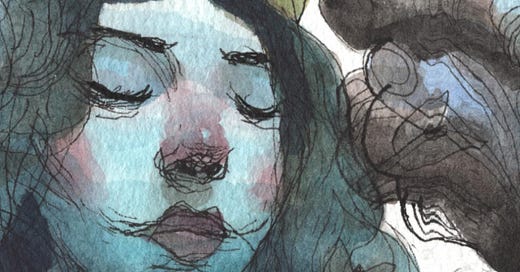New Book: Seven Beggars
A while back I linked to some illustrations I did for a translation of an old Rabbi Nachman story. The translator of that book slapped it all together and put it up for sale as a real bonafide book.
Many PsyCo readers will know Rabbi Nachman as an important early Hasidic figure. And, while most folks are familiar with the pithy sayings of these Hasidic “masters”, fewer have much familiarity with their longer works. And this is mostly because they are much, much weirder.
For some reason, there was an explosion of bizarre imagery in the West at this time that resembled a sort of early, organic surrealism. Nachman’s Beggars is especially rich, but this wasn’t limited just to Hasidic courts. Consider these titles from the other side of the Atlantic at around the same time:
Prelude to the New World, which in the last rosy sunset has appeared as a paradisal refulgence unto the Children of God, Illustrated in Songs of Love, Praise, Suffering, Power and Experience- the crushed, cringing and cross-bearing Church on Earth, and also the Church Triumphant which after a time reveals itself as a foretaste of Paradise. Offered as a sincere watchman’s call to all the children of God who are still scatterered, that they may assemble and prepare for the soon-approaching wedding day of the Bride of the Lamb (dated 1732. Printed by Benjamin Franklin)
The Zionitic Hill of Incense, or Mountain of Myrrh, filled with diverse types of beautiful, sweet-smelling scents; rendered through the Apothecary-art with countless expressions of love by godly souls, formed into numerous and charming spiritual songs, in which the final summons to the Last Supper of the great God is distinctly and beautifully expressed. Illuminated in the Western quarter of the world, in the land of the sunset, toward the midnight coming of the Groom (1739)
The Song of the Solitary and Deserted Turtle-Dove, namely the Christian Church or spiritual and experienceful-songs of Love and Sorrow, as therein both, a foretaste of the new world as well as the intervening roads of the cross and sorrow are presented according to their dignity in spiritual rhymes. By One who is a peaceful and striving pilgrim toward the Silent Eternity, and now gathered together and brought to light for the use of the Solitary and Deserted in Zion. (These are from J. Jablonski’s amazing article: Milennial Soundings)
These are titles from 18th century religious tracts from Ephrata, Pennsylvania, but the approach to imagery is eerily similar to Nachman’s. And that shouldn’t be surprising- they shared influences that were bubbling up in the heretical worlds of the time- whether that be Gottfried Arnold, the hermeticist/alchemists, Joseph Frank, the kabbalah and others- all of which were especially imagistic. And precisely because these movements were heretical, there was a lot of intermingling between traditions.
What is it like to look at the world through this sort of lens? Hard to know, but it coincided with radical changes and a utopian sense of possibility. In both cases, these ecstatic effloresences of imagery would be followed by tamer and more imagination-phobic periods which coincided with less optimism. I don’t want to say it was all peaches and cream- these movements had problems, but there was something unique and important about their worldview. In the history of imagination, they stand out. I don’t know what to make of it all!
It is curious that our own era is marked with a quickly shifting change in our approach to images. If the 18th century Hasids and Ephratans were able to see meaning everywhere, we are able to see it nowhere, and our images tend to be cynical and overly slick, but mostly rendered basically meaningless because they all are trying to sell something, and we know this. There was a time when images didn’t do this.
The Hasids and Ephratans lived in a world where images and imagination were used to connect the chaotic aspects of their lives into a larger moral order, while we live in a world where images disorganize and confuse us. We no longer find ourselves in them.
At any rate, the book was fun to do but be warned: it’s not gonna become a major motion picture anytime soon. It requires a slightly deformed consciousness and it helps if you have the ability to float.





